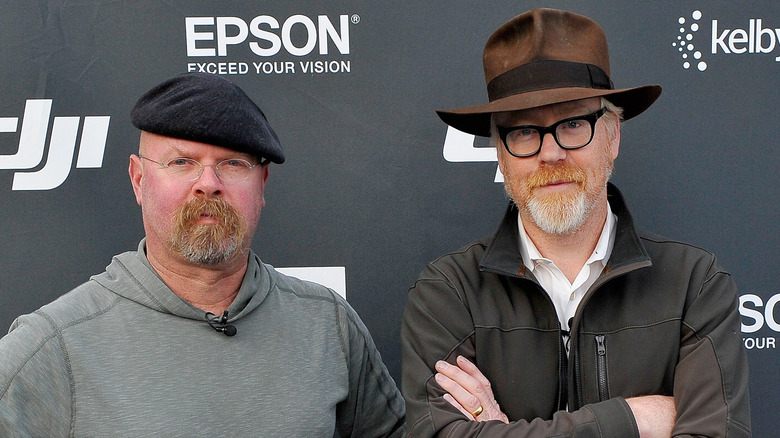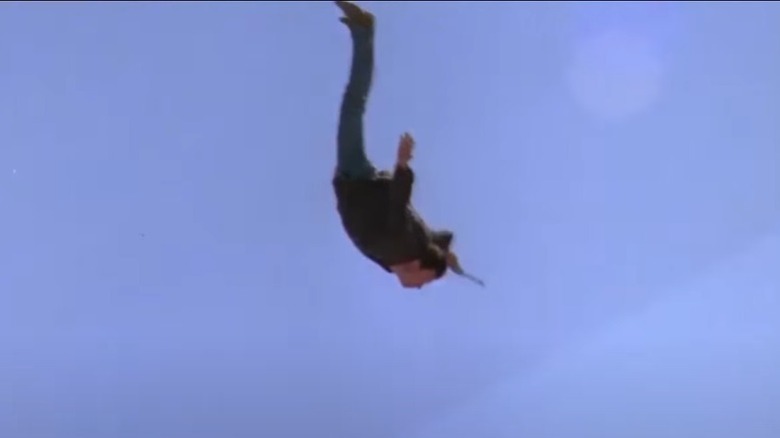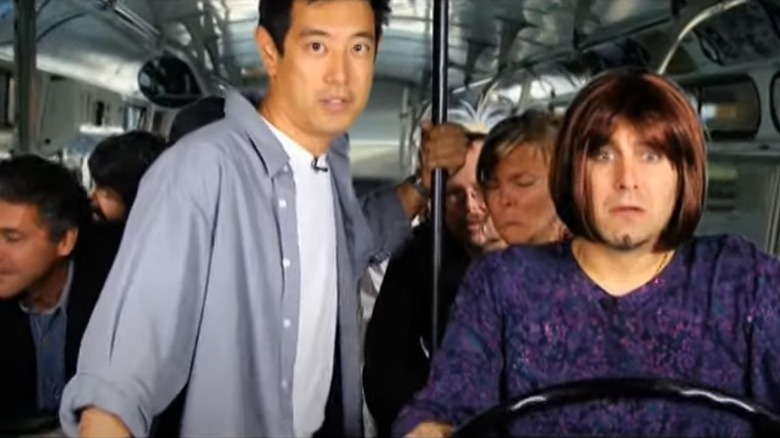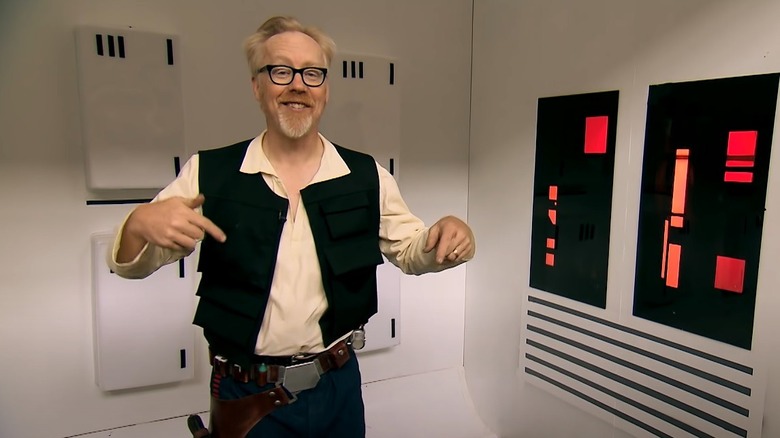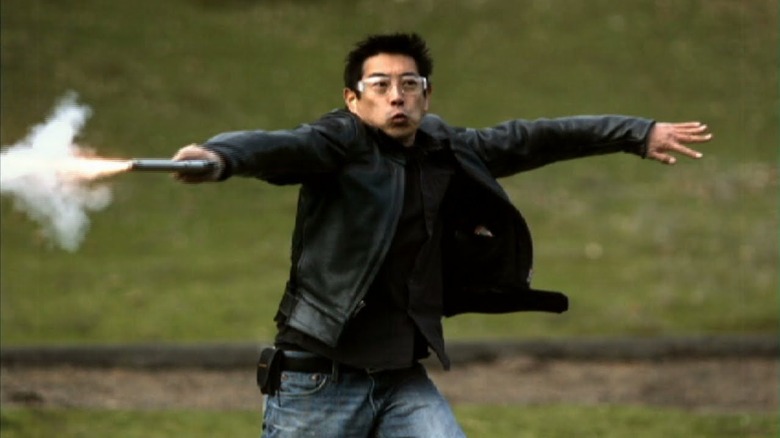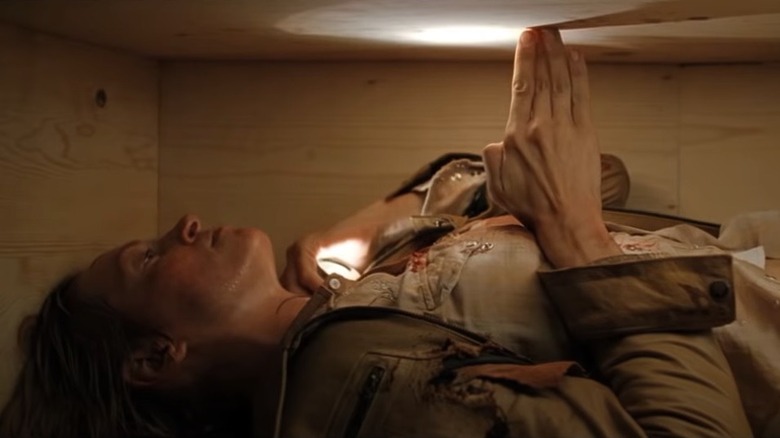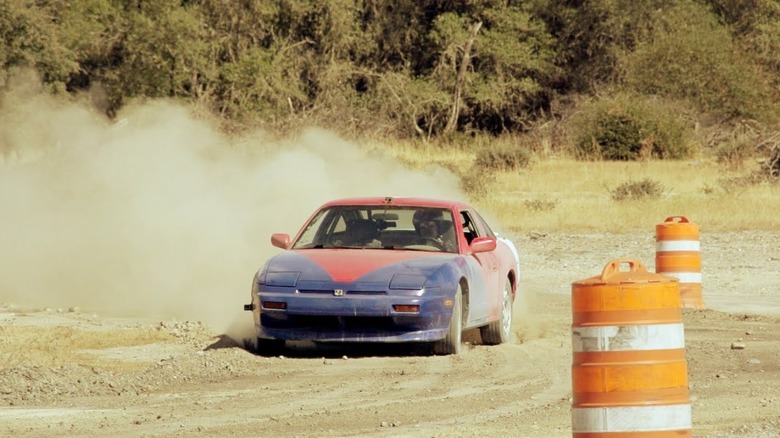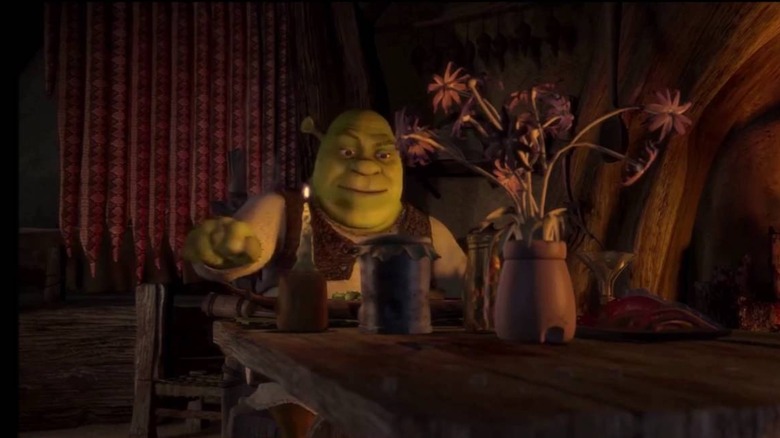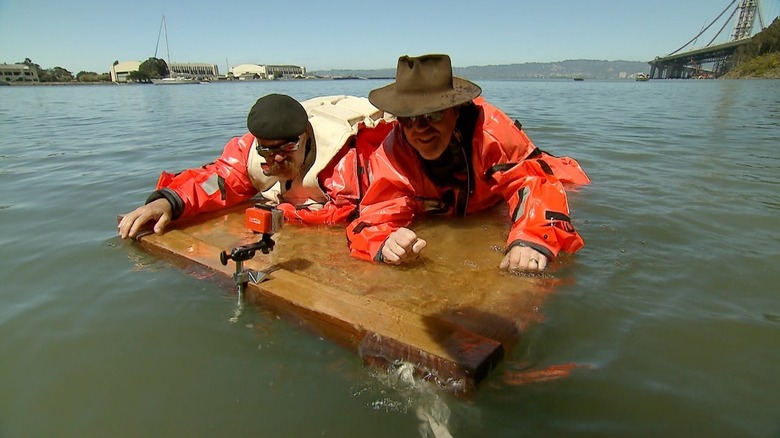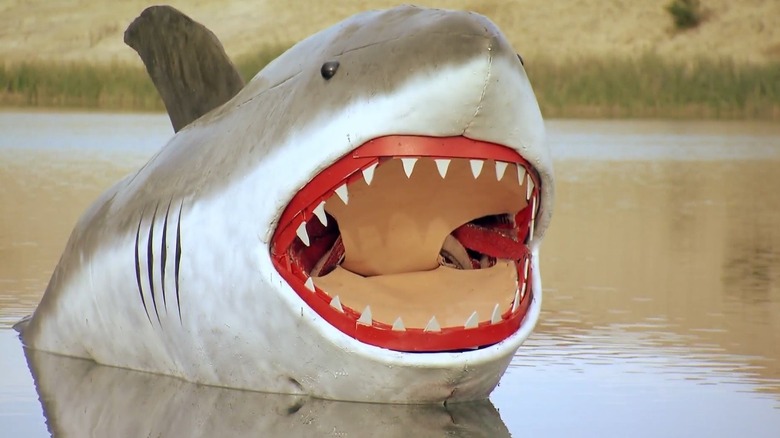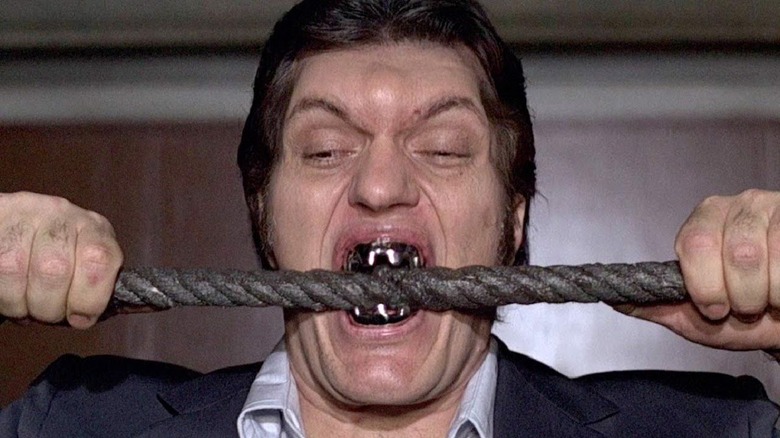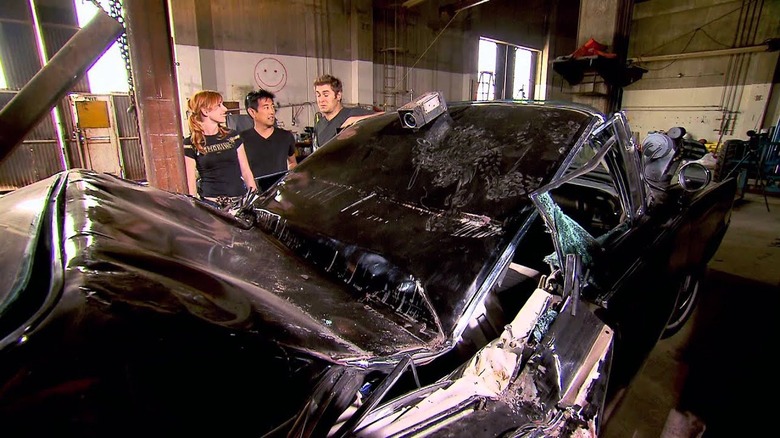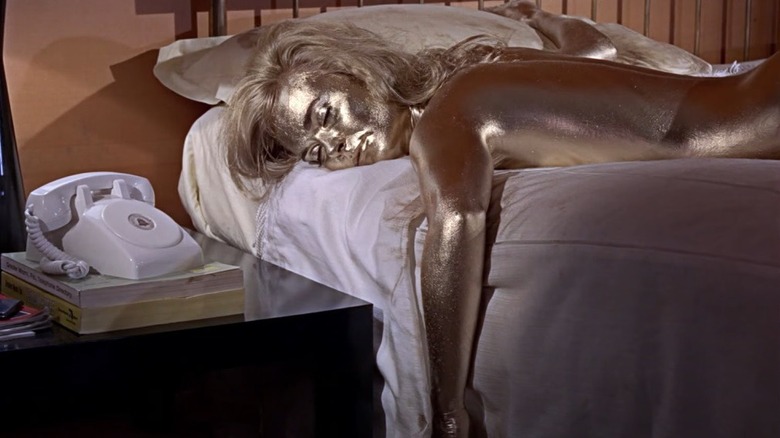Movie Moments Debunked By MythBusters
In the 14 seasons that "MythBusters" ran on TV, the team tested hundreds of myths. Originally, it was just the two main hosts, special effects artists Jamie Hyneman and Adam Savage. Later, they were joined by the Build Team of artist Kari Byron, model maker Tory Belleci, and electrical engineer and roboticist Grant Imahara. In the TV show, the team tested a variety of myths, misconceptions, and urban legends. Some of these tests were incredibly expensive, others were alarmingly dangerous, and quite a few focused on the odd, often logically inconsistent world of movies.
And many of those movies turned out to be a pretty rich playground for the MythBusters. Sometimes, they dove into films that were already well known, like "Jaws" and the James Bond film franchise. On other occasions, more obscure movies like "Point Break" or "The Green Hornet" provided an excuse for flinging members of the Build Team out of an airplane or indulging in the good, old-fashioned MythBusters tradition of blowing something up in spectacular fashion.
Still, between all those explosions and calculations, the truth will eventually come out. While some episodes redeemed a few movie moments, these are the ones that were thoroughly debunked by the MythBusters.
The MythBusters learn that skydiving is really loud
For the MythBusters, a movie like 1991's "Point Break" is rife with myths to test. The film follows the rather improbably named Johnny Utah, an FBI agent played by Keanu Reeves, as he tries to track down some daring and dangerous bank robbers. Utah infiltrates the group and, at one point, goes skydiving with them. The group's ostensible leader, Bodhi (played by Patrick Swayze), has a mid-air conversation with Utah. Seems reasonable enough, at least if you've never been skydiving or even paid attention to real-life skydiving footage.
That's because skydiving is awfully loud, what with all that rushing wind. The MythBusters wondered if it was even remotely possible for a skydiving conversation to take place, or if it would have been a lot of mouthed words and confused looks exchanged between the film's leads.
Grant Imahara was sent up into the sky to test out the theory. Per MythBusters Results, Grant jumped out of a plane (with a parachute, of course) and, while mid-air was approached by a skydiving instructor who attempted to communicate a pre-selected phrase. Grant, perhaps unsurprisingly, couldn't hear a thing. The myth was quickly and thoroughly busted. Maybe Bodhi should have just picked a quiet cafe or beach to have his menacing conversation instead.
The bus jump in Speed was actually always doomed
Listen, we all want Sandra Bullock and Keanu Reeves to be okay. We know they're actors, but it's still pretty stressful to see their characters go through serious trials and tribulations like being trapped aboard a speeding bus equipped with a bomb in 1994 movie "Speed." But would they have really made it through crazy stunts like flinging a bus across a 50-foot gap? You may be unsurprised to learn that in the movie, it works out just fine.
However, the MythBusters conducted a series of experiments that uncovered very different results. The Build Team first ran tests with a small-scale model, according to MythBusters Results. The first test, using scaled-down dimensions, was disastrous for the miniature bus and its imaginary occupants, who went plummeting to their doom in short order.
Even closing the gap didn't seem to help very much, though the Build Team admitted that, if there were somehow concealed ramps on both sides of the gap, the movie stunt might work in the real world. But, when they attempted to recreate the scene in full scale using a remotely operated bus, the team first found that the vehicle had a hard time getting up to the required 70 miles per hour. When they scaled back the distance to account for this discrepancy, the bus still couldn't quite make the leap.
The Stormtroopers will eventually hit someone, even the MythBusters
Many "Star Wars" fans like to joke about the incredibly poor aim of Stormtroopers, who seem doomed to endless shoot at the movies' heroes and yet never seem to strike them. As Popular Mechanics reports, Adam Savage determined that the lasers shooting out of those Stormtrooper blasters are alarmingly slow, moving at only 130 miles per hour. That's compared to an analogue bullet that moves at an estimated 1,700 miles per hour, and we're not even zipping off to a galaxy far, far away on a high-tech spaceship.
So, given the excruciatingly slow speed of a single blaster shot, it should be possible to outrun one, right? Could it be that Luke Skywalker didn't need to be inhumanly fast, after all?
In short, no. Per MythBusters Results, Jamie and Adam found that even those sluggish Stormtroopers would still inevitably catch you. Jamie built a cannon that would gently fire nonlethal foam darts at the appropriate speed to mimic the blaster shots. Both hosts attempted to dodge the foam projectiles in a mock spaceship but just couldn't manage the feat. Even when the assailant was forced to take their time to raise the cannon barrel to shoot, it didn't give the mock Rebel any time to avoid certain doom. Maybe it was the Force helping Luke out, after all.
You can't curve a bullet's path without a really weird gun
In the 2008 film "Wanted," the beleaguered central character of Wesley, played by James McAvoy, finds out that he is linked to a secretive group of super assassins known as Fraternity. Moreover, Wesley learns that, like a super violent Harry Potter, he's actually a very special person who has unique, almost mystical firearms skills. Also, Angelina Jolie is there to teach him how to shoot bullets in a curve.
This last notion, of course, piqued the interest of the MythBusters. Is it really possible to somehow fling a gun around while shooting it and therefore set a bullet on a curved path? Even if you don't account for the sort of high-level math and physics knowledge that would be necessary to skillfully control such a thing, is it even possible in the first place?
Well, no, not unless you have a very strange gun. MythBusters Results reports that the Build Team simply couldn't make it happen, even with their considerable experience on the firing range. Neither could a gun-slinging robot make it happen. It only sort of worked in a later episode, "Bullet Baloney," in which Jamie and Adam improbably managed to fire a bullet out of a gun with a dramatically curved barrel that could even potentially shoot backwards (via Wired).
Even the MythBusters can't punch their way out of a coffin
Being buried alive is surely a nightmare scenario for even the most level-headed person on the planet. As such, it's been an occasional feature of movies where the main character is put in a situation that seemingly has only one end: their doom. That's what happened to the Bride, the main character of Quentin Taratino's Kill Bill movies. In the second film, she's trapped in just such a situation but, given her extensive kung fu training, the Bride's got a unique plan: she's just going to punch her way out.
Using a "one-inch punch" style masterfully demonstrated in real life by martial arts legend Bruce Lee (via Popular Mechanics), she breaks through the coffin and then manages to make her way to the world above.
But could she really have done it? So asked the MythBusters who, per MythBusters Results, decided to put it to the test. Grant created a robot that could approximate a human punch and, key to the experiment, didn't need oxygen to survive. The robot put a crack in the coffin after 600 punches, but that was all it could manage. And, when the Build Team considered what would happen when dirt began to stream into a coffin, the results were pretty dire. Tory was able to extricate himself from 2 feet of dirt, but 6 feet was just too much for a human to manage.
Drifting may look cool, but it's not the best way to drive
The seemingly endless spate of car movies like the ultra-popular "Fast & Furious" film franchise might have you confused about some of the best ways to drive. Surely you already know stunts like the one in "Furious 7" where they jumped a car between buildings in Abu Dhabi are incredibly ill-advised, but what we're talking about here is drifting. Specifically, as the MythBusters wondered: is drifting a car more efficient than simply guiding it through a turn?
Of course, this was a great opportunity for Adam and Jamie to first learn how to drift, though in less flashy cars than what you might have seen on screen. Then, as Nerdist reports, it was time to get down to business. The pair took their cars through a course and a series of 90-degree and 180-degree drifts, compared their runs to a more standard turn-based approach, and then did the math. The results? Drifting was only ever as good as turning, and may even be worse, time-wise. Bluntly put, the physics of a drift just don't make sense. No one tell Dominic Toretto though, or his feelings might get hurt when he realizes he's been doing it all wrong for nine movies.
Earwax candles grossed out even the MythBusters
In what is surely one of the grossest myths ever tested by the MythBusters, the mere sight of a candle could make you start to retch. Inspired by a scene from the animated film "Shrek", this very special, very awful candle was made out of human earwax.
The premise, if you can stomach it, was to see if earwax could replace standard candle wax. The MythBusters wondered if such a candle would hold a steady flame. It worked for Shrek, so why wouldn't it work for the Build Team?
If you can stomach it, this is how the team went about its horrid business: first, the MythBusters met up with an alarmingly helpful ear, nose, and throat doctor, who gave them the collected earwax of hundreds of patients. Only, as Grant told the Atlantic, the doctor wasn't assembling a jar full of the stuff for fun — it was from infected ears. Attempting to melt the stuff into a candle shape produced a stench so awful that Grant had to walk away and viewers everywhere had to hide their eyes. "It was probably the grossest thing I've ever done in my life," he said. And, even worse, it didn't work. The candle never lit. Maybe ogre earwax is just different — and hopefully better-smelling.
Jack could have absolutely fit on that door
In the world of great movie arguments, one stands out head and shoulders above the rest. It concerns "Titanic," the 1997 cinema juggernaut that seemingly had everyone around the world weeping at the tragic love story between Rose and Jack.
In the film, Jack and Rose find themselves in that cold, cold water. It's better than being stuck in a sinking ship, sure, but then the hypothermia sets in. The pair get Rose above the water on a floating door, but Jack can't join her without both of them sinking. He nobly sacrifices himself and everyone in the theater sobs yet again.
Since then, fans have argued pretty strenuously over whether or not both of them could have figured out the door problem. And, according to the MythBusters, there was a solution. First, Entertainment Weekly notes that they used a gelatinous dummy Jamie dubbed ThermoMan to prove that director James Cameron was right in showing Jack succumbing to hypothermia in a short time. But a later test in which Jamie and Adam stood in for the star-crossed lovers proved more complicated. When Jamie realized they could use a period-accurate life vest to add to the door's buoyancy, it became clear that two people could indeed have fit on that chunk of wood and survived after all.
Scuba tanks aren't as explosive as Spielberg thinks
While real great white sharks don't cause that much trouble, director Steven Spielberg's 1975 thriller "Jaws" posits that a single shark could cause a lot of trouble for one unfortunate seaside community. In the end, police chief Martin Brody manages to wedge a scuba tank into the shark's mouth. He shoots the tank, resulting in a chum-heavy explosion.
It's a pretty spectacular scene, but could it happen? This was the subject of two MythBusters episodes, a 2005 "Jaws" special and a 2015 update. In the first, the MythBusters found that a tank that was shot simply decompressed and dramatically flung itself around, but wouldn't explode (via MythBusters Results).
A spate of fan questions over the years pushed the team to revisit the same myth a decade later. As MythBusters Results notes, many had wondered if different kinds of bullets and trajectories might have made it more explosive. Adam and Jamie set to work with a mock shark they named Brewster, but no explosions happened. Then again, when Jamie hit the tank with a sniper rifle, it did shoot through the shark and exited near its tail. That would certainly be a very bad day for a great white, but still no boom.
The MythBusters conclude that Jaws wasn't that strong of a Bond villain
Sure, you may have already concluded that any film featuring a certain British secret agent known as James Bond isn't going to be the most realistic movie out there. While the film franchise has tended somewhat towards more realistic settings in recent years, the initial movies of the 1960s and 1970s were — sorry, fans — oftentimes downright goofy. But that doesn't stop the MythBusters from testing out some of the strangest James Bond scenes.
Take 1979's "Moonraker," where, in one scene, James Bond finds himself in a cable car about to go down. The cause? Jaws, the creatively-named villain with a pair of steel choppers who's about to bite through the cables and send Mr. Bond plummeting to his certain doom.
Alas, cool as those teeth may have been to some viewers, the MythBusters couldn't ignore the plain fact that Jaws' shiny teeth are still attached to a human musculoskeletal system. You can sharpen and strengthen those metal teeth all you want, as MythBusters Results reports that Jamie and Adam did, but unless Jaws was really a superpowered android (and what Bond film would resist that sort of reveal?), he simply could not have chomped through a 1-inch steel cable.
Explosives and bulldozers don't mix except on MythBusters
Though it may have been forgotten by much of the moviegoing public of today, Seth Rogen's attempt at rebooting the Green Hornet superhero in 2011 provided plenty of fodder for a pretty rollicking MythBusters episode. Sure, it was basically a tie-in for a movie that proved to be a critical dud, at least if Rotten Tomatoes is to be believed, but you can't deny that the MythBusters had fun with it all nonetheless in their Green Hornet special
Per MythBusters Results, the team tested out a couple of different movie myths from the film, but one of the most spectacular involved a car, a bulldozer, and lots of explosives. In the movie, two people in a car trapped beneath a bulldozer set off some explosives and throw the heavy equipment off without mortally injuring themselves.
Replicating that scene in real life proved to be tough. Even with some serious shielding, the dummies meant to represent the Green Hornet and his assistant, Kato, were seriously damaged after the first blast (which also caused the bulldozer to sink even more on top of them). Then, in a quasi-successful attempt to get the bulldozer to fly away with 250 pounds of explosives, the car, dummies, and machinery were all torn to shreds by the blast.
Painting your skin gold probably isn't going to kill you
In the 1964 James Bond Film, "Goldfinger", the character of Jill Masterson is killed off via gold paint. Bond finds her dead, covered in the stuff, and later learns that she died of "skin suffocation." As NBC News explains, quite a few people believed that the actress playing Masterson really died from just that.
A bit of digging reveals that the woman who played the ill-fated gold woman, Shirley Eaton, is still alive and well today. She stepped away from acting in the 1960s, leading some in the pre-internet age to think that she might well have died. Nothing of the sort happened, though she did tell Smithsonian Magazine that it took about an hour to scrub the paint off.
But could being painted gold really cause a person to die? That was the question asked by the MythBusters in one of their earliest pilots, aired back in 2003. Per MythBusters Results, Jamie was fully coated in gold paint for an hour and survived just fine. The team revisited the myth just a year later, where it was Adam's turn to go under the paintbrush (via MythBusters Results). He, too, felt okay, though he admitted that the process was uncomfortable and, as NBC News reported, both Jamie and Adam did undergo slight fluctuations in blood pressure and body temperature.
